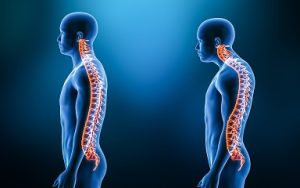 Kyphosis is a relatively common spinal condition. It ranges from a small, barely noticeable abnormal curvature of the spine to a serious spinal deformity causing hunched posture and pain. Thankfully, it’s a condition chiropractors have the power to correct. While symptoms are easily diagnosed, determining the cause of the condition can be more difficult. At St. Paul Chiropractic and Natural Medicine, we’ve seen a broad variety of cases, each with unique catalysts. While the symptoms are the same, the root cause is more diverse. Visiting a chiropractor can provide the necessary insight to determine the cause. More importantly, once a chiropractor knows the root cause, they’ll be able to outline a treatment regimen that addresses both the symptoms and the catalysts behind it.
Kyphosis is a relatively common spinal condition. It ranges from a small, barely noticeable abnormal curvature of the spine to a serious spinal deformity causing hunched posture and pain. Thankfully, it’s a condition chiropractors have the power to correct. While symptoms are easily diagnosed, determining the cause of the condition can be more difficult. At St. Paul Chiropractic and Natural Medicine, we’ve seen a broad variety of cases, each with unique catalysts. While the symptoms are the same, the root cause is more diverse. Visiting a chiropractor can provide the necessary insight to determine the cause. More importantly, once a chiropractor knows the root cause, they’ll be able to outline a treatment regimen that addresses both the symptoms and the catalysts behind it.
Types Of kyphosis
It is a broad diagnosis. There are three types with drastically different causes: Postural, structural, and congenital.
● Postural: It is the easiest to understand, and the easiest to diagnose and treat. Caused by poor posture, this type of kyphosis is most found in people with desk jobs. If you spend a lot of time slouched in a chair or hunched over a computer monitor, your upper back and neck will eventually shift forward. A chiropractor can usually diagnose postural kyphosis by examining your body and discussing both your symptoms and your lifestyle with you. Treatment regimens may involve adjustments, targeted exercises prescribed by a physical therapist, and the adoption of a healthy posture.
● Structural: It can be more challenging to diagnose. In many cases, structural kyphosis is the result of either genetic problems or another underlying spinal problem. Unlike postural kyphosis, it’s impossible to treat structural kyphosis simply by improving your posture. The exact course of treatment depends on its root cause.
● Congenital: It is a genetic condition present at birth. If not caught early in life, it will grow more severe as the body develops. There are different types of congenital kyphosis, including Scheuermann’s kyphosis. These are called primary kyphosis because they’re not a secondary symptom of another condition.
Treatment Of Kyphosis
Treating involves addressing the symptoms of the malformation. Most primary kyphosis cases are easy to spot in infancy or early childhood. Correcting them is done through adjustments, bracing, ad postural training.
Trauma, like car accidents and sports injuries, could also cause secondary kyphosis. Treatment regimens for this type usually mirror treatment for other types of secondary kyphosis. As with postural kyphosis, most forms of structural kyphosis are treated with chiropractic adjustment and physical therapy. In severe cases, surgical treatment may also be necessary.
Spinal healthcare options in St Paul Minnesota
Kyphosis is a condition on the rise thanks to text-neck and other poor posture habits common in our digital lives. If you notice hunching or unnatural sloping in your spine, it’s time to visit a chiropractor. St. Paul Chiropractic offers comprehensive care and a range of spine-related healthcare solutions. To learn more about our approach to spinal health, schedule a consultation and adjustment today!




